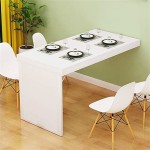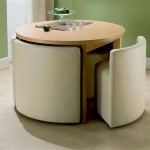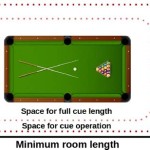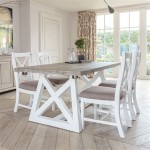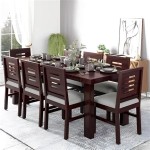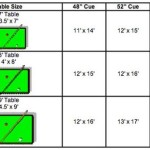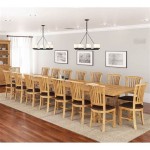The Enduring Appeal of the 42-Round Extendable Dining Table
The 42-round extendable dining table represents a versatile furniture piece suitable for a range of living spaces. Its circular form fosters intimacy and conversation, while the extendable feature addresses the fluctuating needs of households, accommodating both intimate dinners and larger social gatherings. This article delves into the various aspects of this adaptable furniture staple, exploring its design considerations, material options, and practical advantages.
Space Optimization and Conversational Dynamics
One of the primary advantages of a 42-round dining table is its efficient use of space, particularly in smaller dining areas or kitchens. The circular shape allows for easier movement around the table, avoiding the sharp corners that can obstruct pathways. Unlike rectangular tables, round tables distribute seating evenly, encouraging face-to-face interaction and facilitating a more inclusive conversational atmosphere. This is especially beneficial for fostering a sense of connection during meals and social events.
The 42-inch diameter provides a comfortable seating arrangement for four people without feeling cramped. This size is conducive to everyday meals for smaller families or individuals. When the extendable feature is engaged, the table can typically accommodate six or even eight individuals, depending on the extension mechanism and the seating arrangement. This adaptability makes it a practical choice for those who frequently entertain but do not have the space for a large, permanent dining table.
The absence of corners on a round table also contributes to safety, particularly in households with children. The rounded edges minimize the risk of bumps and bruises, creating a more child-friendly environment. This practical consideration further enhances the appeal of a 42-round dining table for families.
Material Selection and Design Aesthetics
The selection of materials for a 42-round extendable dining table significantly impacts its durability, aesthetic appeal, and overall cost. Common materials include solid wood, wood veneer, manufactured wood (such as MDF or plywood), metal, and glass. Each material offers distinct advantages and disadvantages.
Solid wood tables, such as those crafted from oak, maple, or walnut, are prized for their durability, natural beauty, and timeless appeal. Solid wood tables can withstand years of use and often develop a richer patina over time. However, they tend to be more expensive and require more maintenance to prevent warping or cracking. Proper sealing and regular cleaning are essential for maintaining the integrity of solid wood tables.
Wood veneer tables offer a more affordable alternative to solid wood. These tables consist of a thin layer of hardwood veneer applied over a core of manufactured wood. They can mimic the appearance of solid wood at a lower cost. However, veneer tables are less durable than solid wood and are more susceptible to damage, such as chipping or peeling. Repairing damaged veneer can be challenging and may require professional refinishing.
Manufactured wood tables, such as those made from MDF or plywood, are the most budget-friendly option. These tables are typically covered with a laminate or melamine finish, which provides a durable and easy-to-clean surface. Manufactured wood tables are less susceptible to warping or cracking than solid wood, but they lack the natural beauty and warmth of solid wood or veneer. They are also generally less durable and have a shorter lifespan.
Metal tables offer a contemporary and industrial aesthetic. Metal frames are often paired with wooden or glass tabletops. Metal tables are durable and easy to clean, but they can be cold to the touch and may not blend as seamlessly with traditional décor. The choice of metal, such as steel or aluminum, will also influence the table's weight and resistance to corrosion.
Glass tabletops provide a sleek and modern look. They are easy to clean and maintain. However, glass can be fragile and prone to scratching. Tempered glass is a safer option, as it shatters into small, blunt pieces rather than sharp shards. Glass tables can also feel cold and may show fingerprints easily.
The design aesthetics of a 42-round extendable dining table encompass a wide range of styles, from traditional to contemporary. Traditional tables often feature ornate detailing, such as carved legs or intricate inlays. Contemporary tables typically have clean lines, minimalist designs, and understated finishes. The choice of style should complement the existing décor of the dining area or kitchen.
Extension Mechanisms and Practical Considerations
The extension mechanism is a crucial element of a 42-round extendable dining table. There are several types of extension mechanisms, each with its own advantages and disadvantages. Common mechanisms include butterfly leaf extensions, drop-leaf extensions, and self-storing leaf extensions.
Butterfly leaf extensions are stored beneath the tabletop and fold out to extend the table. This type of extension is relatively easy to use and requires minimal storage space. However, the butterfly leaf may not be as sturdy as other types of extensions, and the joint between the leaf and the tabletop may be visible.
Drop-leaf extensions consist of hinged leaves that fold down on either side of the table. This type of extension is suitable for small spaces, as the table can be easily converted from a small round table to a larger oval or rectangular table. However, drop-leaf extensions can be less stable than other types of extensions, and they may require additional support when extended.
Self-storing leaf extensions are stored within the table and can be easily deployed when needed. This type of extension is convenient and provides a seamless extension of the tabletop. However, self-storing leaf extensions may add to the overall weight and complexity of the table.
Beyond the extension mechanism, several other practical considerations influence the choice of a 42-round extendable dining table. These include the table's stability, ease of assembly, and maintenance requirements. A stable table is essential for safe and comfortable dining. The table should be able to withstand the weight of food, dishes, and diners without wobbling or tipping. Ease of assembly is also important, particularly for those who prefer to assemble furniture themselves. Tables that are easy to assemble can save time and frustration.
Maintenance requirements vary depending on the material and finish of the table. As mentioned earlier, solid wood tables require regular cleaning and sealing to prevent warping or cracking. Laminate tables are easy to clean with a damp cloth, while glass tables may require special glass cleaner to remove fingerprints and streaks. Understanding the maintenance requirements of a particular table is essential for ensuring its longevity and preserving its appearance.
The choice of chairs to accompany a 42-round extendable dining table is also an important consideration. The chairs should be comfortable, stylish, and appropriately sized for the table. The height of the chairs should allow for comfortable dining without feeling too high or too low. The style of the chairs should complement the design aesthetics of the table and the overall décor of the dining area or kitchen. The number of chairs should be sufficient to accommodate the typical number of diners, but also be able to expand with the table's extension.
In conclusion, the 42-round extendable dining table offers a compelling combination of space efficiency, conversational dynamics, and adaptability. Its circular form fosters intimacy, while the extendable feature accommodates fluctuating needs. By carefully considering the material selection, extension mechanism, and practical considerations, individuals can select a 42-round extendable dining table that perfectly suits their lifestyle and enhances their dining experience.

Mid Century Rounded Expandable Dining Table 42 80 West Elm

Mid Century Rounded Expandable Dining Table 42 80 West Elm

Polibi Natural Wood Wash Farmhouse Round Extendable Dining Table With 16 In Leaf Rs Frewdt16 Nw The Home

Urtr 42 In 58 Round Espresso Wood Top Extendable Dining Table Farmhouse Kitchen Room With X Shaped Base T 02009 P The Home

Mid Century Rounded Expandable Dining Table 42 80 West Elm

42 Emmond Mid Century Modern Round Dining Table Natural White Threshold

Round Pedestal Extension Table Dining With Leaf Hunt Country Furniture

Urtr 42 In 58 Round Natural Wood Wash Top Extendable Dining Table Kitchen Room With X Shaped Base T 02009 E The Home

Mid Century Rounded Expandable Dining Table 42 80 Room Small

Urtr 42 In 58 Round Natural Wood Wash Top Extendable Dining Table Kitchen Room With X Shaped Base T 02009 E The Home

